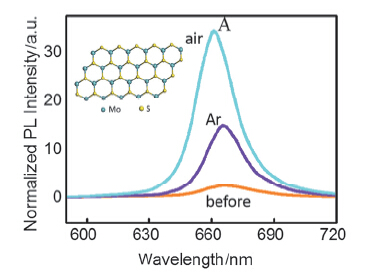| [1] Wang, Q. H.; Kalantar-Zadeh, K.; Kis, A.; Coleman, J. N.; Strano, M. S. Nat. Nanotechnol. 2012, 7, 699.
[2] Zhang, Y.-Q.; Liang, Y.-M.; Zhou, J.-X. Acta Chim. Sinica 2014, 72, 367. (张芸秋, 梁勇明, 周建新, 化学学报, 2014, 72, 367.)
[3] Geim, A. K.; Novoselov, K. S. Nat. Mater. 2007, 6, 183.
[4] Chhowalla, M.; Shin, H. S.; Eda, G.; Li, L. J.; Loh, K. P.; Zhang, H. Nat. Chem. 2013, 5, 263.
[5] Splendiani, A.; Sun, L.; Zhang, Y.; Li, T.; Kim, J.; Chim, C.-Y.; Galli, G.; Wang, F. Nano Lett. 2010, 10, 1271.
[6] Mak, K. F.; He, K. L.; Shan, J.; Heinz, T. F. Phys. Rev. Lett. 2010, 105, 136805.
[7] Julien, C.; Sekine, T.; Balkanski, M. Solid State Ionics 1991, 48, 225.
[8] Late, D. J.; Liu, B.; Matte, H. S. S. R.; Dravid, V. P.; Rao, C. N. R. ACS Nano 2012, 6, 5635.
[9] Li, H.; Yin, Z.; He, Q.; Li, H.; Huang, X.; Lu, G.; Fam, D. W. H.; Tok, A. Y.; Zhang, Q.; Zhang, H. Small 2012, 8, 63.
[10] Mak, K. F.; He, K.; Lee, G. H.; Hone, J.; Heinz, T. F.; Shan, J. Nat. Mater. 2013, 12, 207.
[11] Tongay, S.; Zhou, J.; Ataca, C.; Liu, J.; Kang, J. S.; You, L.; Li, J.; Grossman, J. C.; Wu, J. Nano Lett. 2013, 13, 2831.
[12] Ross, J. S.; Wu, S.; Yu, H.; Ghimire, N. J. Jones, A. M.; Aivazian, G.; Yan, J.; Mandrus, D. G.; Xiao, D.; Yao, W.; Xu, X. Nat. Commun. 2013, 4, 1474.
[13] Dolui, K.; Rungger, I.; Pemmaraju, C. D.; Sanvito, S. Phys. Rev. B 2013, 88, 075420.
[14] Peimyoo, N.; Yang, W.; Shang, J.; Shen, X.; Wang, Y.; Yu, T. ACS Nano 2014, 8, 11320.
[15] Lin, J. D.; Han, C.; Wang, F.; Wang, R.; Xiang, D.; Qin, S.; Zhang, X.-A.; Wang, L.; Zhang, H.; Wee, A. T. S.; Chen, W. ACS Nano 2014, 8, 5323.
[16] Zhang, J.; Yu, H.; Chen, W.; Tian, X.; Liu, D.; Cheng, M.; Xie, G.; Yang, W.; Yang, R.; Bai, X.; Shi, D.; Zhang, G. ACS Nano 2014, 8, 6024.
[17] Ji, Q.; Zhang, Y.; Gao, T.; Zhang, Y.; Ma, D.; Liu, M.; Chen, Y.;Qiao, X.; Tan, P.-H.; Kan, M.; Feng, J.; Sun, Q.; Liu, Z. Nano Lett. 2013, 13, 3870.
[18] Mouri, S.; Miyauchi, Y.; Matsuda, K. Nano Lett. 2013, 13, 5944.
[19] Eda, G.; Yamaguchi, H.; Voiry, D.; Fujita, T.; Chen, M.; Chhowalla, M. Nano Lett. 2011, 11, 5111.
[20] Yue, Q.; Shao, Z.; Chang, S.; Li, J. Nano Res. Lett. 2013, 8, 425. |
